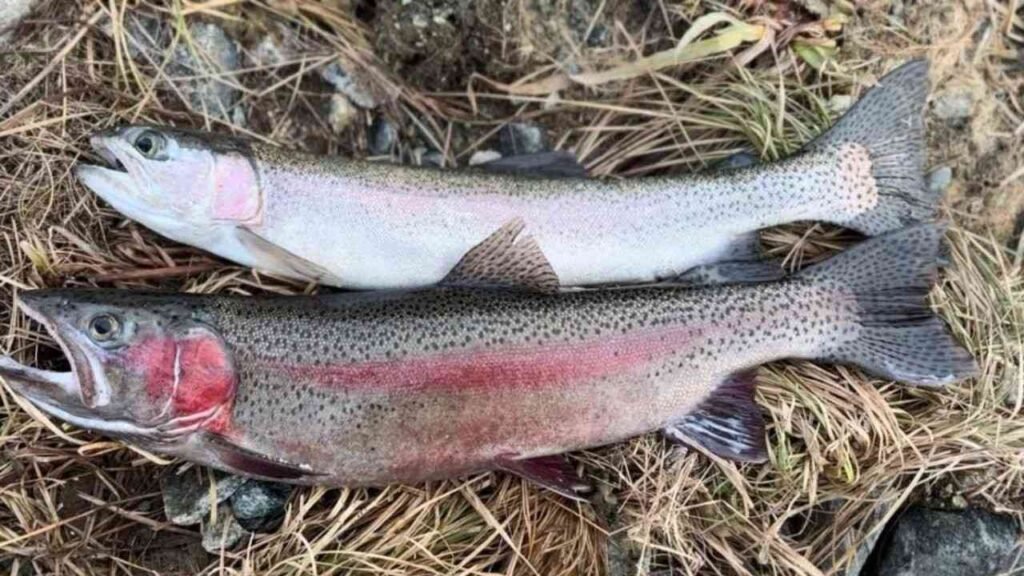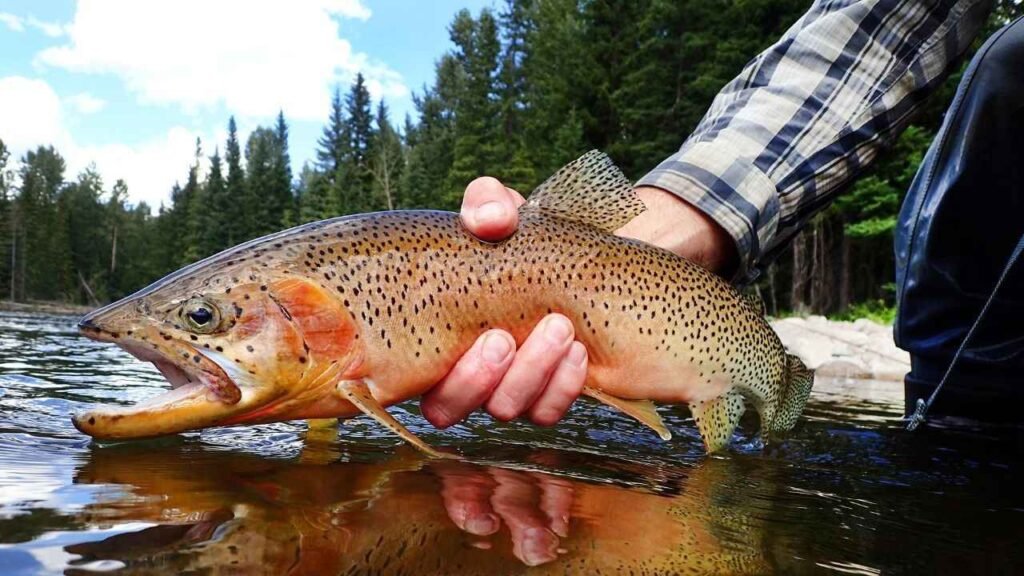Steelhead and rainbow trout are the same species but differ in their life cycles. Steelhead migrate to the ocean, while rainbow trout stay in freshwater.
Steelhead and rainbow trout, both belonging to the species Oncorhynchus mykiss, exhibit notable differences due to their life cycles. Steelhead trout are anadromous, meaning they migrate to the ocean before returning to freshwater to spawn. This journey to the ocean influences their size and coloration, often making them larger and more silvery than rainbow trout.
Rainbow trout, on the other hand, live their entire lives in freshwater. This difference in habitat creates distinct physical and behavioral characteristics between the two. Anglers and biologists alike find these differences fascinating and important for both sport fishing and conservation efforts.
Introduction To Steelhead And Rainbow Trout
Steelhead and Rainbow Trout are fascinating fish. They look similar but have key differences. Understanding these differences can enhance your fishing experience.
Species Overview
Steelhead and Rainbow Trout are the same species, Oncorhynchus mykiss. The main difference lies in their lifecycle. Steelhead are anadromous, meaning they migrate to the ocean and return to freshwater to spawn. Rainbow Trout remain in freshwater throughout their lives.
Habitat And Distribution
Rainbow Trout thrive in cold, clear freshwater streams and lakes. They are native to North America but have been introduced to other parts of the world.
Steelhead are found in coastal rivers and streams that connect to the ocean. They are mostly found along the Pacific coast of North America.
| Feature | Steelhead | Rainbow Trout |
|---|---|---|
| Lifecycle | Anadromous | Freshwater |
| Habitat | Coastal rivers, ocean | Freshwater streams, lakes |
| Distribution | Pacific coast of North America | North America, introduced worldwide |

Credit: gotfishing.com
Physical Characteristics
Understanding the physical characteristics of Steelhead and Rainbow Trout helps in identifying them. These fish species have notable differences in size, weight, coloration, and markings.
Size And Weight
Steelhead and Rainbow Trout vary significantly in size and weight.
- Steelhead: They grow between 20-40 inches. They weigh 8-20 pounds.
- Rainbow Trout: They are smaller, usually 12-16 inches. They weigh 2-8 pounds.
Coloration And Markings
Coloration and markings distinguish Steelhead from Rainbow Trout.
Steelhead:
- Have a shiny, silver body.
- Exhibit a pink to red stripe along the sides.
- Possess fewer spots on the tail and back.
Rainbow Trout:
- Showcase a vibrant, greenish-blue body.
- Feature a distinct pink to red stripe on the sides.
- Are covered with dark spots on their entire body, including fins.
These physical characteristics help in correctly identifying Steelhead and Rainbow Trout in the wild.
Life Cycle And Behavior
The life cycle and behavior of Steelhead and Rainbow Trout share similarities but also have distinct differences. Understanding these aspects can help anglers and enthusiasts better appreciate these remarkable fish species.
Spawning Patterns
Both Steelhead and Rainbow Trout have unique spawning patterns. Rainbow Trout spawn in freshwater rivers and streams during the spring. They lay their eggs in gravel nests called redds.
Steelhead, on the other hand, are anadromous. They migrate from the ocean to freshwater rivers to spawn. They typically spawn in late winter to early spring. Steelhead also create redds for their eggs.
Migration Habits
Migration habits differ significantly between the two species. Rainbow Trout remain in freshwater throughout their lives. They inhabit lakes, rivers, and streams.
Steelhead exhibit a fascinating migration pattern. After hatching, they spend one to three years in freshwater. Then, they migrate to the ocean, where they spend another one to four years before returning to freshwater to spawn.
This migration cycle can occur multiple times in a Steelhead’s life, a behavior known as iteroparity. Rainbow Trout do not exhibit this migration behavior.

Credit: www.youtube.com
Diet And Feeding Habits
Steelhead and rainbow trout, while similar in many ways, have distinct diet and feeding habits. Understanding these differences can help anglers and enthusiasts appreciate these unique fish species.
Natural Prey
Both steelhead and rainbow trout are opportunistic feeders. Their natural prey includes:
- Insects: Mayflies, caddisflies, and stoneflies.
- Small Fish: Minnows and young fish.
- Crustaceans: Crayfish and freshwater shrimp.
- Worms: Earthworms and aquatic worms.
Despite these similarities, there are key differences in their diet based on their environment. Rainbow trout, often found in freshwater, primarily consume insects and small fish. On the other hand, steelhead, which spend part of their life in the ocean, have a more varied diet. They include more crustaceans and larger fish in their meals.
Feeding Techniques
Feeding techniques also vary between steelhead and rainbow trout.
Rainbow trout rely on their keen eyesight to spot prey. They often feed near the water’s surface, snatching insects from the air or water. These fish can also be seen darting to catch small fish and crustaceans.
Steelhead, having experienced ocean life, exhibit more aggressive hunting techniques. They often chase down larger prey, using speed and strength. In freshwater, they maintain similar habits but adapt to available food sources.
Both species have adapted to thrive in their respective habitats. Understanding these feeding habits can enhance fishing strategies and ecological studies.
Habitat Preferences
Steelhead and Rainbow Trout are fascinating fish with unique habitat preferences. Understanding these preferences helps anglers and nature enthusiasts appreciate their differences. Let’s dive into the environments these fish thrive in.
Freshwater Vs Saltwater
Rainbow Trout primarily live in freshwater. They inhabit rivers, lakes, and streams. These fish prefer clear, cold waters with plenty of oxygen.
On the other hand, Steelhead are more adventurous. They are anadromous, meaning they live in both freshwater and saltwater. Steelhead hatch in freshwater, migrate to the ocean, and return to freshwater to spawn.
Preferred Environments
Rainbow Trout prefer environments with vegetation and shade. They often hide under rocks and logs. This provides them with protection from predators and helps them ambush prey.
Steelhead have a varied environment preference. In the ocean, they prefer coastal waters. These waters are rich in food sources. In freshwater, they seek out fast-flowing streams and rivers. These environments provide the oxygen-rich water they need to thrive.
| Fish | Freshwater | Saltwater | Preferred Environment |
|---|---|---|---|
| Rainbow Trout | Yes | No | Vegetation, Shade, Clear, Cold Water |
| Steelhead | Yes | Yes | Coastal Waters, Fast-flowing Streams and Rivers |
Fishing Techniques
Both Steelhead and Rainbow Trout are popular targets for anglers. Their behaviors and habitats differ, requiring specific fishing techniques. This section will explore the best seasons, effective baits, and lures for catching these prized fish.
Best Seasons
The fishing season for Steelhead varies based on their migratory patterns. They are typically most active during the fall and spring runs. Rainbow Trout, on the other hand, are more predictable. They can be fished year-round, but the best times are spring and fall when water temperatures are moderate.
| Fish | Best Seasons |
|---|---|
| Steelhead | Fall and Spring |
| Rainbow Trout | Spring and Fall |
Effective Baits And Lures
Choosing the right bait and lure increases your chances of catching Steelhead and Rainbow Trout.
- Steelhead: Use roe, worms, and shrimp. Spinners and spoons work well too.
- Rainbow Trout: PowerBait, worms, and small minnows are effective. Fly fishing with nymphs and dry flies is also popular.
Different techniques apply to these species. For Steelhead, drift fishing and float fishing are common. Rainbow Trout are often caught using fly fishing and spin casting.
Using the right gear is crucial. A medium-action rod works best for Steelhead. For Rainbow Trout, a light to medium rod is ideal. Ensure your reel and line match the fish size to avoid breakage.
Understanding these techniques increases your success rate. Happy fishing!
Conservation And Threats
Steelhead and Rainbow Trout are vital to our ecosystems. Both face significant threats that jeopardize their populations. Understanding these threats is crucial for effective conservation.
Environmental Challenges
Steelhead and Rainbow Trout face many environmental challenges. Climate change affects water temperatures and flow patterns. Warmer waters can stress these fish, disrupting their life cycles.
Pollution from agricultural runoff and industrial waste contaminates their habitats. This pollution depletes oxygen levels and introduces harmful chemicals.
Dams and other man-made barriers restrict their migration routes. These barriers prevent them from reaching spawning grounds, which impacts reproduction rates.
Conservation Efforts
Conservation efforts aim to protect and restore these species. Key strategies include:
- Habitat Restoration: Rehabilitating streams and rivers to improve water quality.
- Barrier Removal: Removing dams and obstacles to restore natural migration paths.
- Regulation and Policy: Enforcing fishing limits and creating protected areas.
Community involvement plays a crucial role. Local groups organize clean-up efforts and habitat restoration projects. Education campaigns raise awareness about the importance of these fish.
Government agencies and non-profits collaborate on research and monitoring programs. These programs track population health and identify emerging threats.
| Threat | Impact |
|---|---|
| Climate Change | Alters water temperatures and flow patterns. |
| Pollution | Contaminates habitats and reduces oxygen levels. |
| Dams | Obstructs migration and spawning routes. |
By addressing these challenges, we can help ensure the survival of Steelhead and Rainbow Trout. Conservation is a community effort, requiring everyone’s participation and support.

Credit: moretrout.com
Choosing between steelhead and rainbow trout can be challenging. Both fish offer unique experiences and flavors. Steelhead are migratory, whereas rainbow trout are freshwater dwellers. Anglers and food enthusiasts appreciate both for different reasons. Understanding their distinctions helps in making an informed decision.
Enjoy the best of both worlds in your fishing and culinary adventures.
FAQs:
What Is The Main Difference Between Steelhead And Rainbow Trout?
Steelhead are rainbow trout that migrate to the ocean. Rainbow trout typically stay in freshwater. This migration impacts their size and color.
Do Steelhead And Rainbow Trout Look Different?
Yes, steelhead are usually larger and have a more metallic sheen. Rainbow trout are smaller with a more vibrant coloration.
Where Can You Find Steelhead And Rainbow Trout?
Steelhead are found in both freshwater and saltwater. Rainbow trout primarily inhabit freshwater environments like rivers and lakes.
Are Steelhead And Rainbow Trout The Same Species?
Yes, both are the same species, Oncorhynchus mykiss. The main difference is steelhead’s migratory behavior.



